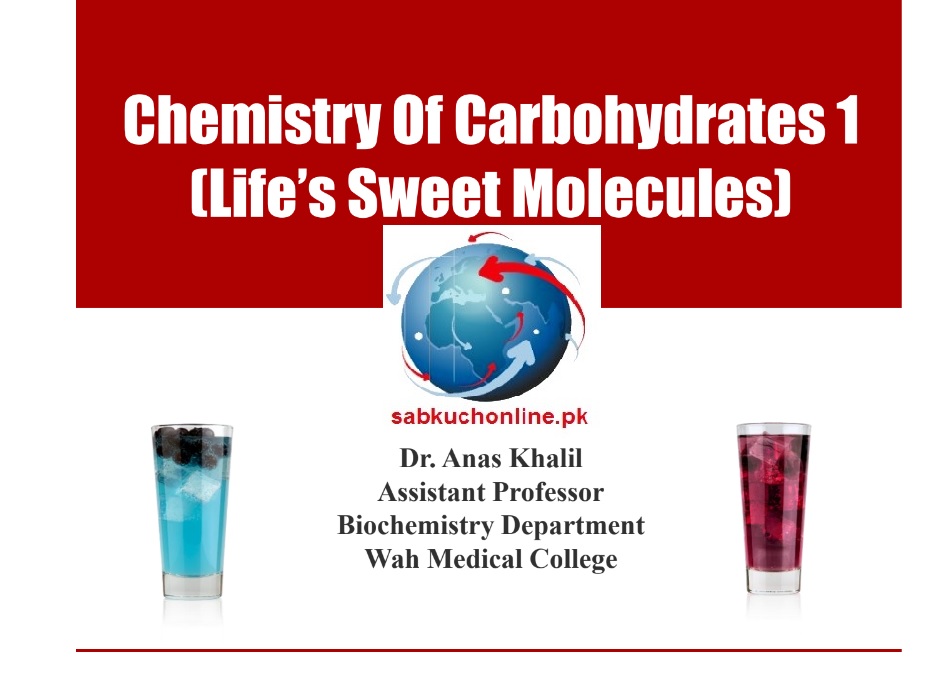Learning Outcomes
- Define carbohydrates
- Explain biochemical functions of
- carbohydrates
- Classify carbohydrates

Carbohydrates
- Carbohydrates are also called Saccharides (Greek Sakcharon meaning Sugar). Carbohydrates are the most abundant biomolecule on earth and one of the main macromolecules that living things are made up of
- They are organic compounds mainly composed of Carbon, Hydrogen and Oxygen. Many carbohydrates also contain Nitrogen and other elements
What are Carbohydrates?
- Hydrates of Carbons (or Carbon Hydrates)
- Carbon + H2O
- Cn(H2O)n

Note: Not all carbohydrates contain exactly 2:1 ratio of H:O as of water, and is true for only the basic units of carbohydrates.
Define Carbohydrates
- Carbohydrates are polyhydroxy aldehydes (H-C=O) or ketones (C=O), containing at least 3 carbon atoms.

Can you Visualize Either Aldehyde Or Ketone Group In ThisPolyhydroxy Alcohol?

But on hydrolysis it yields an Aldehyde and a Ketone


So the complete definition of carbohydrates will be:
CARBOHYDRATES ARE POLYHYDROXYLATED COMPOUNDS WITH ATLEAST THREE CARBON ATOMS, WITH POTENTIALLY ACTIVE CARBONYL GROUPS WHICH MAY BE EITHER AN ALDEHYDE OR KETONE GROUP; THEY ALSO CONTAIN THOSE COMPOUNDS, WHICH YIELD THEM ON HYDROLYSIS.
Functions Of Carbohydrates
- They are the chief source of energy.
- Glycocalyx coat helps in cell recognition.
- They can act as antigens.
- Their degradation products act as promoters or catalysts.
- Carbohydrates derivatives (such as cardiac glycosides, antibiotics) are used as drugs.
- They can be used to synthesize fatty acids, cholesterol, amino acids, etc.
- They form nucleic acids which store genetic information.
- They form structural components in the body.
- They form bulk of stool and prevent constipation.
Classification of CHO
- Based on Hydrolysis / Sacchar Units
- Based on functional group
- Based on Isomerism
Based on Hydrolysis and Number of Sacchar Units
- Monosaccharaides (1 sacchar unit)
- Disaccharides (2 sacchar units)
- Oligosaccharides (3 to 10 sacchar units)
- Polysaccharides (more than 10 sacchar units)
Monosaccharides
- Simple sugars, consisting of a single sacchar unit
- These are the simplest form (or basic units) of carbohydrates which cannot be hydrolyzed.
- Completely Soluble in water
- Low molecular weight
Monosaccharides can be further classified or grouped on the basis of:
- Aldehyde or Ketone Group
- Aldoses (Aldomonosaccharides)
- Ketoses (Ketomonosaccharides)
- Carbon Chain Length
- Trioses (3 Carbons)
- Tetroses (4 Carbons)
- Pentoses (5 Carbons)
- Hexoses (6 Carbons)
- Heptoses (7 Carbons)
Examples of Monosaccharides:
| CARBON ATOMS | ALDOSE | KETOSE |
| 3C (TRIOSE) | GLYCERALDEHYDE | DIHYDROXYACETONE |
| 4C (TETROSE) | ERYTHROSE | ERYTHRULOSE |
| 5C (PENTOSE) | RIBOSE, XYLOSE | RIBULOSE, XYLULLOSE |
| 6C (HEXOSE) | GLUCOSE, GALACTOSE, MANNOSE | FRUCTOSE |
| 7C (HEPTOSE) | GLUCOHEPTOSE | SEDOHEPTULOSE |
Disaccharides
- Consist of 2 Sacchar Unit
- Usually soluble in water
- Higher molecular weight than monosaccharides
- Examples???
Sugarcane Sugar

Milk Sugar

Oligosaccharides
- Carbohydrate consisting of 3 to10 sacchar units
- Less Soluble in water
- Higher molecular weight
- These have less importance in human body
- Examples:
- Maltotriose, Raffinose, Stachyose, Dextrins.
Polysaccharides
- Complex carbohydrate consisting of more than 10 sacchar units
- Not Soluble in water
- Higher molecular weight
- Can be further classified on 2 basis:
- The type of monomers (Homo & hetero polysaccharides)
- Function (Structural, Storage & Water Binding Polysaccharides)
Based on functional group

Based on Isomerism
- Enantiomers (Differ at penultimate carbon) L and D forms
- Epimers (Differ at a Carbon other than anomeric carbon or the penultimate carbon)
- Anomers (Differ at the anomeric carbon) α and β forms
